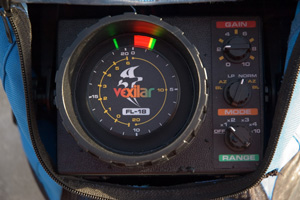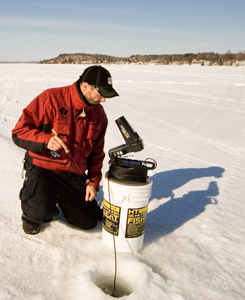
Electronics play a vital role in ice fishing. Portable fish finders, underwater cameras, GPS units and two-way radios are not gadgets but tools, and using them will make you a better angler. Using electronics on the ice helps you find and catch fish faster than without them. For more information on why you should utilize electronics this ice season, read on.
Electronics play a vital role in ice fishing. Portable fish finders, underwater cameras, GPS units and two-way radios are not gadgets but tools, and using them will make you a better angler. Using electronics on the ice helps you find and catch fish faster than without them. For more information on why you should utilize electronics this ice season, read on.
 |
| LED displays on ice fishing sonars have three color variations to represent signal intensity. |
Fish Finders
There's no doubt about it -- you'll catch more fish if you use a portable fish finder on the ice. Over the years, I've fished beside folks not using finders, and the results are often staggering. Simply put, those of us using electronics consistently out fish anglers who don't.
Fish finders help you locate fish below the ice. Just as important, though, is that they show you how fish react to your bait. Watching the unit's display, you can monitor a fish's reaction to different jigging sequences as you try to trigger those fish to strike. When you know you've attracted fish, simply experiment with different jigging moves and lures until you find a pattern the fish will hit.
Portable fish finders come in two styles: LCD displays, such as the MarCum ShowDown Ice Troller Handheld Fishfinder, and color LED flasher displays, such as MarCum Technologies LX-5 Dual Beam True Color Ice Fishing Sonar. MarCum's model is designed so that the vertical display matches the water column for easy signal interpretation. MarCum flashers operate differently, displaying information in a circle. It takes a couple outings with a MarCum to get comfortable interpreting the data; some combos are sold with instructional DVDs to help you get up and running quickly.
One benefit to LED displays is the three color variations for signal intensity. Learning to interpret these colors helps you differentiate between different bottom compositions, lets you know if you're fishing above weeds, the proximity of fish to your lure and much more.
Underwater Cameras
Underwater cameras have many on-ice applications. They're great for scouting cover and structure. With a camera you can assess the health of weeds, find weed edges, figure out bottom composition and see if any fish are in the area. This is handy for pre-ice scouting from a boat or when ice fishing a new lake for the first time.
Like flashers, cameras let you monitor your bait and watch a fish's behavior as you try and get it to bite. Before sight fishing through the ice was limited to clear, shallow water. Now, you can sight fish at any depth in clear to moderately turbid water with a camera. You'll learn a lot from watching fish and how they position themselves in relation to your lure. Small moves away or towards the bait are great indications if your jigging sequence is enticing or not. Of course, when fish are feeding, it's exciting to watch them aggressively strike a bait.
 |
| The author watches the display of his underwater camera to see how fish react to his bait and jigging cadence. |
Many ice anglers prefer the "down view" function — positioning the camera so it's above the bait. This method gives a wide view, letting you see fish approaching from 360 degrees. Side viewing does have its applications, though, especially if you're set up on a point or a route way. Position the camera in a hole further away from you to determine when fish are swimming towards your bait so you can intercept them. Side viewing is also best for scouting.
A range of cameras are available, from basic entry-level models to full-color, flat screen ones, such as the MarCum Underwater Viewing System Model vs825sd. If you plan to use your camera to scout water, buy a model that will display the camera's direction. This makes it easier to pinpoint areas you've spotted with your camera. Water temperature and camera depth are two additional options to think about when shopping for an underwater camera.
Handheld GPS Units
Handheld GPS units are just as effective on the ice as they are on open water. You can store spots as waypoints, improving how quickly you can locate them the next time you're out. They're particularly handy when covering large distances on snow machines or ATVs. This is particularly true if you're fishing a new lake. Contour lines help you quickly locate shoals, points, breaks and other critical fish-holding features beneath the ice. Just make sure you've purchased a map chip, like Navionics HotMaps Platinum Multi-Dimensional Lake Maps, for contour data.
One thing to keep in mind when using GPS units is that cold temperatures quickly drain batteries. You're best to keep the unit inside your jacket when not in use and carry plenty of spare batteries. If traveling large distances or exploring backwoods lakes, make sure you have an alternative navigation method, like a map and a compass, in case the GPS unit fails or batteries die.
Two-Way Radios
Splitting up in small groups to fish a variety of different spots can help you quickly find fish. Two-way radios let you keep in contact with other anglers on the ice. They also make it easy to let others in the group know when you've found a good bite or hot bait so that others can join you, or at least use the details and try similar strategies at their location.
Of course, you don't need to be separated by vast distances to use radios. They're just as handy to chat with angling pals, even when you're only a few yards away. This is helpful when fishing out of portable huts where it's often difficult hear each other, even with raised voices.
If investing in radios, opt for ones with a wide signal range to ensure you'll keep in contact if you spread out over large distances.
Ice fishing electronics will improve your catch rates. Fish finders and underwater cameras help you find fish-holding areas and hook more fish than if you were angling without them. Portable GPS units let you store your best spots and explore new ones by uploading fishing map data into the device. Lastly, two-way radios let you share information with angling partners so you can work together to locate fish and share patterns. Put all these tools together and you'll be well equipped for the hard-water season this year.
- 7265 views

